L2 Learners' Perceptions of Teachers' Roles in EFL Settings
Leila Sayah, Reza Pishghadam, Behzad Ghonsooly and Azar Hosseini Fatemi, Iran
Leila Sayah teaches at Farhangian University of Ahvaz-Iran. She is interested in TEFL, discourse Analysis and sociology. She has published some articles in different journals. E-mail: sayah2015@gmail.com
Reza Pishghadam is a full professor at Ferdowsi university of Mashhad-Iran. He has published numerous articles and different books on TEFL and sociolinguistics. His current interests are TEFL, Sociolinguistics, discourse analysis, psychology, and language education. E-mail: pishghadam@um.ac.ir
Behzad Ghonsooly is a full professor at Ferdowsi university of Mashhad-Iran. He has published manifold articles and different books on TEFL and assessment. His current interests are TEFL, language testing and ESP. E-mail: ghonsooly@ferdowsi.um.ac.ir
Azar Hosseni Fatemi is an associate professor at Ferdowsi university of Mashhad-Iran. She has published various articles on TEFL and sociology. Her current interests are second language teaching and learning. E-mail: hfatemi@ferdowsi.um.ac.ir
Menu
Abstract
Introduction
Theoretical framework
Methodology
Results
Discussion and conclusion
References
Appendix A
Appendix B
Appendix C
Teacher-learner relationships have long been investigated in a considerable literature to build an effective teaching and learning environment. Yet recent literature on teachers' or learners' centeredness ignored the students' perceptions contributing to create a positive relationship with their teachers or to develop cognitive and behavioral effectiveness. To fill this gap, to some extent, it was determined to design a questionnaire focusing on the learners' perceptions concerning their teachers' roles considering the subjective cultural elements as social interpersonal, religious and political roles. 730 male and female students from public schools and private English language institutes participated in this study. Principle Component Analysis extracted five underlying factors in the study. Further, the questionnaire was validated through Structural Equation Modeling (SEM) using the LISREL program and influential fit indices were observed. When analyzing the perceptions of the learners in two settings, the dominance of cultural role over other roles was confirmed. Consequently, it was recommended to emphasize the importance of local home culture to improve the students' belittling religious, political, and professional roles of their language teachers.
Teacher- learner collateral relationships in a safe appropriate teaching environment would promote teacher- learner autonomy and facilitate learning process and teaching success (Tiberius, 1999). To direct the students toward the professional achievements is to secure this relationship by investigating the learners' different types of perceptions. Bourdieu (1991; 1984) acknowledges the influence of the individuals' perceptions in the process of identity formation and asserts that the individuals provided with proper perception and expressions which are prerequisites of cultural goods would be more competent and effective in school accomplishments. Realizing the students' different notions about their teachers' attitudes, interests, and different roles is probably one of the key factors in ascertaining educational developments (Adeyemo, 2011). That is to say, the extent to which the individuals develop appropriate perceptions in the delicate stages of identity construction would be possibly consistent with their assumptions about their teachers' different roles and characteristics.
Since different roles of teachers as the knowledge containers were changed subsequently and through years to mentors, counselors, and friends in a modernized system of education, ( Nunan 1993). This extrovert connection might be strengthened or weakened by the type of the perceptions learners develop about their teachers' roles in the educational settings. Creating safe student- teacher relationships could be sustained when we realize what perceptions the learners conceptualize of their teachers. Moreover, the students' self concepts, their attitudes towards their teachers and schooling could contribute to better school organizations (Silins & Murray-Harvey, 1995).
Yet, recent literature about teacher's or learner's centeredness ignored the students' perceptions which contribute to creating positive relationships with their teachers and developing certain cognitive and behavioral perspectives (Ampadu, 2012; Christiansen, 1982; Furmin and Li, 2012; Goodson and Cole, 1994; Kuzusanto, Ismail, & Jamil, 2010; McCroskey & Teven, 1997; Voller, 1997; Yoon, 2004). The interconnection between different cultural, social interpersonal, religious and professional roles of teachers as the most influencing individuals developing fundamental efficacy in the students' perceptions have not been fully recognized. Moreover, the substantial influence of teachers' roles in building positive teacher- learner relationship that emplace these individuals in pros or cons of each other has been neglected.
Since the students' perception of their teachers' social interpersonal, professional, cultural, and religious roles as the human elements of subjective culture (Keith, 2011) would influence their identity formation, and the subjective culture is attributed to shared meaning systems, social practices, religious values, and language (Markus, Kitayama & Heiman, 1997), it was attempted to design a new questionnaire on the basis of the subjective culture factors each measuring the teachers' roles in identity construction of students.
It was determined to administer the designed learners' perceptions' (LP) questionnaire among males and female students of public schools and English language institutes since achieving a safe environment full of mutual understanding, support, as well as knowledgeable achievements could be maintained thoroughly in one specific context meant to teach and learn lifelong skills _ school (Wayne & Youngs, 2003). Besides, it would provide constant, methodical and monotonous training which enables the individuals to have a considerable production (Bourdieu, 1984). The other main objective to select these two settings was to discover the significant differences between the perceptions of the students who voluntarily and desirably study English with those participants who pass English as a mandatory course in public senior high schools.
Teachers exert a powerful impact on the students' experiences, their success or failure (Parsley & Corcoran, 2003; Yoon, 2004). They might manifest their roles of facilitators, counselors, and resources when they promote decision- making processes in the classroom, meet the continuous needs of the students, and provide their knowledge and expertise available for the students (Voller 1997). The teachers' active roles in developing the students' different learning strategies and autonomy might facilitate language acquisition (Yang 1998). At the same time, the diverse roles of teachers could impact the identity of the students if the students develop positive perceptions about their teachers' attitudes, believes, and methods. The trusting and collaborative climate, a shared and monitored missions, taking initiatives and risks, and continuous professional development (Mulford, 2003) could be exercised at schools when the students promote positive perceptions of their teachers' different roles.
The following few studies investigated the teachers' different roles and the students' perceptions of their teachers in the process of language learning.
Students' Perceptions
Christiansen (1982) identified the importance of teacher-student relationships and the students' perception in the school success, and found that building relationships in the classroom could be promoted through recognizing the students' perceptions of their language teachers. McCroskey and Teven (1997) realized that the students' proficiency level in assessment and their cognitive learning are influenced by the students' perceptions of their teachers. The more powerful they positioned their teachers, the best they could develop their language learning strategies.
Kuzusanto, Ismail, and Jamil (2010) designed a questionnaire to identify the students' perception of their teachers' behavior among the lower and higher achievers and found that the students perceived their controlling behavior of their teachers as one of the roles that decreases their self esteem and their teachers' supportive behavior would definitely increase their self esteem. Ampadu (2012) investigated the students' perceptions of their teachers' multiple roles in exercising diverse methods and realized that the majority of the students confirmed the teacher centered approaches in language settings.
Teachers' roles
Regarding professional role, Goodson and Cole (1994) investigated the link between the professional identity of teachers' roles and professional community. They found that the boundaries of micro-political and contextual realities hold back the professional development of teachers at schools and compel them to either transit to a new professional community that best fits their expertise or change their roles and notions in an attempt to adapt to the current educational settings.
Yoon (2004) investigated the influence of the teachers' beliefs, attitudes, and roles on the students and found that the teachers' different roles had a direct relation with the major of the students. When they interacted with general English students, their roles did not meet the cultural and social needs of the students but dealing with English language learners, they could manifest their multiple roles in shaping the students' identities.
Furmin and Li (2012) designed a questionnaire on four different roles of teachers in facilitating students’ autonomy. They found that the role of teachers as resource facilitators score the highest and classroom organizers was the least important role. They also found that the roles of learning regulators and study guides were the secondary important roles in ESL classes.
Undoubtedly, learners' beliefs and motivation are interlinked and their perceptions of the target language community or learning activity may affect their motivation and learning accomplishments (Hall, 2011), and the teachers' professional (Hightower, Delgado, Sterling, Lloyd, Wittenstein, Sellers, & Swanson, 2011) cultural, social interpersonal, religious, and political roles may penetrate the personality of language learners for a life time. Yet, the students' perceptions of their teachers' different characteristics and roles affecting their achievements and identity construction had not been fully analyzed. We know little about the students' views and expectation concerning their language teachers' different cultural elements and whether these perspectives attach or detach the students from their own culture, society, and religion. Taking these into account; it was determined to investigate the students' perceptions of their teachers' influential roles in educational settings by designing the LP questionnaire. To this end, this study attempted to ascertain two objectives. First, it was intended to validate the LP questionnaire on the basis of Structural Equation Modeling (SEM) using LISREL program. Second goal was to recognize the differences between male and female students' perceptions of their teachers' different roles in the two settings of public schools and English language institutes. The age range specified in the study spans from 15 to 18 as the critical age of identity formation (Coleman 1992).
Research method
Quantitative and qualitative methods were utilized to investigate the perceptions of males and female students of public schools and English language institutes' concerning their teachers in their process of identity formation with regard to their different identity roles as social interpersonal, cultural, professional, religious, and political factors.
Participants
730 students including 414 public school students (180 males, 234 females) and 316 students of English language institutes (148 males, 168 females) with the age range of 15 to 18 from four various districts of Ahvaz- a city in Iran - participated in the study. Fixed age range of 15 to 18 could be observed in senior high schools while students with different age range were identified in English language institutes. This limitation caused different methods of samplings in the settings under study. Random method of sampling was chosen in senior high schools by choosing either odd or even numbers of the students written on the schools' official lists. Non random sampling was administered in different English language institutes considering their age range regardless of their level of proficiency. This led to administering the questionnaire among a large number of English language institutes' learners to obtain the same age range as senior public school students. Excluding the non relevant age range and fragmentary answered questionnaires, 730 questionnaires out of 1300 questionnaires were attained as the final data in this study.
Instrumentation
The designed questionnaire was proposed by the researchers to identify the learners' perceptions of their teachers' roles in two settings of senior high schools and private English institutes. The questionnaire included 33 items and is a likert questionnaire questionnaire. The scoring ranged from (1) strongly disagree to (5) strongly agree.
Procedure
This study included two main phases: First, it was attempted to design LP questionnaire and then to administer it to the students of public schools and English language institutes. Second phase included achieving the reliability and validity of the questionnaire as well as analyzing the data. When designing the questionnaires' items in the first phase of the study, the researchers determined to focus on the essential factors contributing to the learning process in the Iranian system considering basic social, cultural, religious, political, and professional parameters. To attain the accuracy of the questionnaire's items, a couple of experts analyzed the wording of the items of the questionnaire. Each statement sought one of different teachers' roles in the process of identity formation in accordance with the students' perception. The data accumulation started in December 2013 in both public schools and English languge institutes. The students were requested to respond the questions regarding their current instructor in 20 minutes. The students were required to write their age, gender, and the name of their school or institutes. The confidentiality of the results was also affirmed by the researchers.
Second phase of the study consisted of three significant stages. At first, Cronbach alpha was performed to explore the overall reliability of the questionnaire questions and the questionnaire's latent factors. The suitability of the questionnaire items was identified through Kaiser-Meyer-Olkin Measure of Sampling Adequacy (KMO) and Barlett’s Test of Sphericity. Principal Component Analysis (PCA) and correlation matrix for coefficient were deployed to realize the parallel analysis of the questionnaire's items. To ascertain the exact number of latent variables and their items, Varimax with Kaiser PCA orthogonal rotation for normalization and the Scree test diagram were applied. In the second stage of the analysis, construct validity of the questionnaire was affirmed through a process of SEM via LISREL program version 8.8. In the third stage of the analysis, preliminary assumption testing was conducted to check normality, linearity, univariate and multivariate outliers, homogeneity of variance-covariance matrices, and multi collinearity, with no serious violations noted. Further, MANOVA was performed to investigate the probable difference between male and female students' perceptions of public schools and English language institutes in terms of their teachers' roles. Different dependent variables were used: cultural, religious, social interpersonal, professional, and political roles. The independent variables were gender and school. Finally, the frequency results of all statements were also calculated to identify the number of cases found in each category.
Construct validity
KMO and Bartlett's Test of adequacy were administered to explore the suitability of the 33 questionnaire items and since the initial Eigenvalues of all items were more than .4, they were retained in the questionnaire. The result of the Kaiser-Meyer measure of sampling of 33 items was higher than .6 and was estimated at .792 and the significance of Bartlet's test of Scphericity (p=.000) promoted the adequacy of the model (see Table 1)

PCA revealed 9 components with the Eigenvalues more than 1.00. As it is observed in Figure 1, to realize the number of factors, the Scree test plot was deployed and five factor solutions of groupings in the questionnaire items were specified.
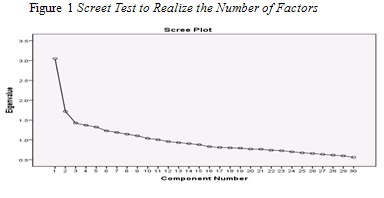
Varimax with Kaiser PCA orthogonal rotation for normalization, shown in Table 2 was applied to realize the number of factors and their statements. The result of Varimax was mostly higher than .5 and we could retain all five factors of the questionnaire.
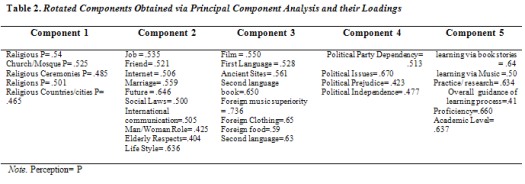
Considering different life practiced values and the students' expectations, five factors in the designed questionnaire were distinguished as professional, religious, cultural, social interpersonal and political perceptions. The items and percentage of each factor would be presented in Table 3.

Reliability of the questionnaire
To acquire the reliability of the questionnaire, Cronbach's Alpha was applied and the reliability of 33 items questionnaire was estimated at .80. All five factors retained in the questionnaire with the reliability ranging from .76 to .81.
SEM
To validate the internal relationships between the five factors, SEM was deployed using LISREL Program (See Figure 2 in Appendix A). Social interpersonal perceptions had a sharp convergence with religious, political, and cultural roles but low correlation with professional roles. The most common calculated fit indices via LISREL program are goodness of fit (GFI), Normed fit index (NFI), Incremental fit index (IFI), Comparative fit index, Tucker Lewis index (TLI) and the root mean square error of approximation (RMESA). As it is observed in Table 4, fit indices like GFI, CFI, and NFI, were all larger than .9, the RMSEA was estimated at 0.04, and the division of Chi- square by degree of freedom was 2.06.

Questionnaire results
First one-way multivariate analysis of variance (MANOVA) was run to explore the relationship between the fixed variables of gender and school and the latent variables among males and female students of public schools and private English language institutes. To realize the likrly differences among the groups on a linear combination of the dependent variables, Wilk's Lambda in the multivariate test was estimated. As it is observed in Table 5, the Wilk's Lambda was obtained as .98 with the significant level of p= .01, F= 2.79 and partial eta squared of .01. Since it was less than .05, we could conclude that there were statistically significant differences among males and female students of public schools and English language institutes in terms of their overall identity perceptions.

As it is seen in the tests of between-subjects effects box, (Table 6) our dependent variables with their associated univariate F, df and significant values are listed. In the Sig. column, regarding gender, school and gender- school comparison, values of cultural role (CR) and political role (PR) are less than .017 and they are almost .04 and .04 with the partial eta squared of .006 and .004 respectively. The sharp decrease in attaining the differences among males and female students of public schools and English language institutes could be observed in realizing cultural role in male and females' differences. The other significant differences could be observed in realization of political, cultural, and social interpersonal differences in comparing gender and school variables (see Table 6).
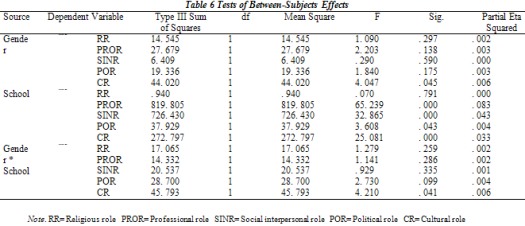
When comparing the mean groups of the male and female students in the current study, and as it is observed in Table 6, the significant differences could be found in the perceived professional role in comparison with the cultural role with the estimated marginal means of 14.3 and 45.7.
The significant frequency differences pinpointing the perceptions of the language learners focusing on two independent variables of gender and school would be presented in Tables 7 to 10 in appendices B and C to avoid loading the study with numerous tables. As it is presented in Table 7, significant differences could be observed among male and female students of the two settings in the items like the superiority of English over mother tongue as one of the statements of cultural role. The harsh increase was perceived among English institutes' learners. Regarding the professional role, significant differences could be observed in both settings (see Table 8). Both males and female students of English institutes outnumbered their counterparts in acknowledging their language teachers' proficiency level.
All five items of religious role exhibited a harsh decline in private English language institutes in comparison with public schools. Both male and female students of public schools revealed significant differences with those of English language institutes regarding their perceptions of religious place (see Table 9). As it is presented in Table 10, public school male students revealed considerable differences with their counterparts in English language institutes regarding political independence though the frequency of 'undecided' was also significant in both genders of public schools.
In this study, it was intended to pinpoint the students' perceptions of their teachers' different roles in the current educational system. To this end, two crucial objectives of the study were ascertained to maintain the general perceptions of the students. First, it was determined to validate the designed LP questionnaire among male and female students of public schools and English language institutes. Second goal was to highlight any possible differences among the students of the so- called settings regarding their genuine perspectives and views about their teachers.
To achieve the first goal of the study, various attitudes of the teachers were designated regarding current social interpersonal, religious, political, and cultural views. PCA and Sree test diagram brought out the valid five groupings of the items and the results of Cronbach's Alpha provided a reliable questionnaire. Five essential groupings were delineated as professional, social interpersonal, religious, cultural, and political roles with 6, 10, 5, 8, and 4 items respectively. To substantiate the construct validity of the 33 items questionnaire, SEM was deployed using the LISREL program. The common goodness of fit indices like GFI, CFI, and NFI were all larger than .9, and RMSEA was estimated at .04, and they revealed good fit indices of the model.
When scrutinizing the second goal of the study as to realize the difference between males and female students' perceptions of their teachers' roles in both settings of public schools and English language institutes, we observed significant realizations. Religious and political roles were amongst the least practiced roles of language teachers in both settings among both genders according to the learners. Each role is to be analyzed subsequently considering their possible interrelated relationships.
Though religious and political roles were the least identified roles which made the majority of the students of both settings question the reasons of adopting such statements for English language teachers still a considerable number of the public school students specially females confirmed the English teachers' practicing religious role in public schools. They develop their own thoughtfulness without being enforced by the usual religious perceptions controlled by elders (Gire, 2011). That is to say, it is not the authorities or their parents effectuating them to reveal certain perceptions of their teachers. It seems that they develop their own considerations when perceiving their teachers' actual representation of religious roles in public schools. Furthermore, it could be resulted from their identity status of being more foreclosures- practicing commitment and developing a sense of authority and respect to the elders, and moratoriums –actively engaged in attempts to make commitments (Marcia, 1966). However, the significant differences between the two settings could probably be rationalized first to the content of English books and second to the secularity of the religious education. In public school books, one out of 30 lessons of grade one to four is about religion and there is no single lesson on the political and patriotism in public school books. The books exercised in English language institutes, contrastingly, are thoroughly foreign and exclusively follow the concept of separating religion from the schooling pinpointing the religion as the revolutionary dilemma which is expensive, counterfactual, and even counterintuitive (Atran, 2007).
Professional role was also de- valued mostly by the public school students since teachers of English language institutes are under constant pressure to be more innovative and effective because of not having job security ( Pishghadam & Sahebjam, 2012) while public school teachers do not have any fear of losing their job and some even apply the traditional methods and techniques. The second crucial reason is that public school teachers implement the decisions made by the government asserting the 'centrality' of educational system against the 'decentralized' system of education in English institutions in which teachers have more options and freedom to select their own materials (Pishghadam, Shapoori, & Shayesteh, 2011, [p. 6]). Like Goodson and Cole's study (1994), these contextual boundaries may weaken the professional development of teachers, and may confine their personal and social potentials. On the other hand, facilitating power and leadership of teachers (Mulford, 2003) in exercising the latest methods and techniques and selecting the relevant materials may contribute to the school effectiveness and success. Moreover, the students would cherish their teachers' professional role and unanimously perceive them as professional models. Since, developing a professional model could promote the students' individualistic and social behaviors, (Kitayama, Duffy, & Uchida, 2007) directing the type of perception the students develop could help the individuals sustain high consensual relationships within the students' groups and with their teachers.
English language superiority over the first language as one of the items of cultural role was mostly perceived by both male and female learners of English language institutes and some students of public schools. The reason could be traced back to the prohibition of applying mother tongue in English language institutes that implies preferring second to first language. On the contrary, since most public schools comprise students with low to average English levels, English language teachers are demanded to use as much mother tongue as they can to suit the system. This contradiction between the two setting's language efficiency has brought about the superiority of English over mother tongue perception. For these learners, English language institutes' teachers are recognized as the elites whose proficient application of English certifies educational success (Choudhury, 2008) and so English as the global means of communication entails the development of power in this favorable position (Cain, 2008).
Seemingly, practicing strong command of English influences these students' perception on the superiority of English power over the local language. That is to say, English language determines perceptions. For the students of both public schools and English language institutes detachment from home culture is seemingly the significant reason of their perception concerning their teachers' preference of second language to first language. Since culture and specifically, language could guide the perpetual substantial cognitive performances ( Marcus & Hamedani, 2007), it seems vital to overcome the detachment from home culture by promoting cultural awareness about the systematic application of mother tongue in both settings to manifest the cognitive effectiveness of the target language system without discriminating the local language culture.
Considering social interpersonal role, the significant differences between the participants of the two settings could probably be resulted from the students' false perception of English teachers adopting the same habits, customs, and principles of non local cultures. Students of both settings and especially English language institutes' participants exhibited some sort of delocalization (Tomlinson, 1999). That is to say, they believed in English teachers' inclination toward English culture and the teachers' detachment from local culture.
The results of this study were contrary to Neuliep, Chaudoir, and McCroskey's (2011) study in which they emphasized the strong manifestation of ethnocentrism and home attachment in similar homogenous cultures. Holding an analogous culture would not be a cogent parameter of home attachment since some individuals and specially young adolescents are infatuated by the global culture, media, technology, and industrialization and are affected by _''artistic, media, and pop cultural representations in the practicing of cognitive and behavioral scripts'' (Helfgott, 2008, p. 371) .
Depicting teachers as role models with the erroneous perception of being a non local culture procurator could heighten the transformation to a non- local identity and the individuals casually develop home detachment while struggling to focus on globalization (Sayah, Pishghadam, Ghonsooly, & Hosseini Fatemi, 2014). On the other hand, improving the learners' sense of connectedness and commitment (Kitayama, Duffy, & Uchida, 2007) could purposefully attach them more to their local values and principles.
The fundamental significance of this study could be observed in two different attainments of educational settings. The first influential significance is for teachers who could use their own plans, methods, and innovations when discovering the students' perceptions of their teachers' roles in both settings. They could also develop a gradual initiation and awareness of exploring their own identity in a more comprehensive manner (Soenens et al., 2011). Furthermore, the second significance of the study would be pertinent to the syllabus designers who could go beyond the boundaries of an educational system in which modernism, transmission of knowledge from western countries to non-western countries (Pishghadam & Shirmohammadi, 2012), and the concept of frame switching integrating two cultures (Miller, 2011) are dominant. They can purposefully design the content of English books of either private English language institutes or public schools focusing on home culture' beliefs and principles while considering the second language different cultural perspectives.
The researchers acknowledge two particular limitations of this study. First, the age range of the participants were 15- 18 while other researchers could administer the questionnaire among the students of different ages ranges. Second, the study could be administered in different institutes (like institutes for university entrance preparation) besides English language institutes or public schools to realize the verifications of the students' views about their teachers. Therefore, it would be profitable for other researchers to conduct such a study by changing the settings, the age range of the language learners or focusing on their field of study. It is also advantageous to add more demographic factors as the age range of teachers, their educational degrees, and their work experiences to realize the overall interconnected perceptions of the students' about their teachers' social interpersonal, religious, professional, cultural, and political roles as different elements of the individuals' life perceptions.
Ampadu, E. (2012). Students’ perceptions of their teachers’ teaching of mathematics: the case of Ghana. International online Journal of Educational Sciences, 4 (2), 351-358.
Atran, S. (2007). Religion’s social and cognitive landscape an evolutionary perspective In S. Kitayama, & D. Cohen (Eds.), Handbook of cultural psychology (pp. 417-453). New York: The Guilford Press.
Adeyemo, S. A. (2011). The effect of teachers’ perception and students’ perception of physics classroom learning environment on their academic achievement in senior secondary. International Journal of Educational Research and Technology, 2(1), 74-81.
Bourdieu, P. (1990). The Logic of practice. Cambridge: Polity.
Bourdieu, P. (1984). Outline of a sociological theory of art perception In P. Bourdieu (Ed.), The field of cultural production: Essays on art and literature (pp. 1-27). Columbia: ColumbiaUniversity Press.
Cain, T. M. (2008). Do you speak global?: The spread of English and the implications English language teaching. Canadian Journal for New Scholars in Education,1(1),1- 11
Choudhury, R. ( 2008). Examining language learning from a critical perspective. TESOL & Applied Linguistics, 8(1), 1-3.
Christiansen, J. (2002). Student/teacher relationships and school success: Perceptions of students from grades nine to twelve. Unpublished MA thesis, University of Lethbridge. Alberta.
Coleman, J. (1992). The nature of adolescence. In J. Coleman (Ed.), Youth policies in the 1990's: The way forward, (pp. 8-27). London: Routledge, Taylor & Francis Books Ltd.
Fumin, F., & Li, Z. (2012). Teachers’ roles in promoting students’ learner autonomy in China. English Language Teaching, 5(4), 51-56.
Gire, J. (2011). Cultural variations in perceptions of aging In K. D. Keith (Ed.), Cross cultural psychology contemporary themes and perspective (pp.110-129). United Kingdom: Wiley- Blackwell.
Goodson, I. F., & Cole, A. L. (1994). Exploring the teacher’s professional knowledge: Constructing identity and community. Teacher Education Quarterly, 21(1), 85–105.
Hall, G. (2011). Exploring English language teaching language in action. London and New York: Routledge.
Helfgott, J. B. (2008). Criminal behavior theories, typologies and criminal justice. USA: Sage publications.
Hightower, A. M., Delgado, R. C., Sterling C. Lloyd, S. C., Wittenstein, R., Sellers, K.,& Swanson, C. B. (2011). Improving student learning by supporting quality teaching: Key issues, effective strategies. Bethesda: Editorial Projects in Education.
Keith, K.D. (2011). Introduction to cross-cultural psychology In K. D. Keith (Ed.), Cross cultural psychology contemporary themes and perspective (pp. 3-19). United Kingdom: Wiley-Blackwell.
Kitayama, S., Duffy,S., & Uchida, Y. (2007). Self as cultural mode of being In S. Kitayama, & D. Cohen (Eds.), Handbook of cultural psychology (136-174). New York: The Guilford Press.
Kuzusanto, P., Ismail, H. N., & Jamil, H. (2010). Students' self esteem and their perceptions of their teacher behavior: A study of between class ability groupings. Electronic Journal of Research in Educational Psychology, 8(2), 707-724.
Marcia, J.E. (1966). Development and validation of ego-identity status. Journal of Personality and Social Psychology, 3 (5), 551-558.
Markus, H. R., & Hamedani, M. G. (2007). Sociocultural psychology the dynamic interdependence among self systems and social systems In S. Kitayama, & D. Cohen (Ed.), Handbook of cultural psychology (pp. 3_39). New York: The Guilford Press.
Markus, H. R., Kitayama, S., & Heiman, R. (1997). Culture and “basic” psychological principles In E. T. Higgins & A. W. Kruglanski (Eds.), Social psychology: Handbook of basic principles (pp. 857–913). New York: Guilford.
Mulford, B. (2003). School leaders: Changing roles and impact on teacher and school effectiveness. Paris: OECD.
Neuliep, J. W., Chaudoir, M., & McCroskey, J. C. (2001). A cross-cultural comparison of ethnocentrism among Japanese and United States college students. Communication Research Reports, 18, 137–146.
Nunan, D. (1993). From learning-centeredness to learner-centeredness. Applied Language Learning, (4), 1-18.
Parsley, K., & Corcoran, C. A. (2003). The classroom teacher's role in preventing school failure, Kappa Delta Pi Record, 84-88.
Pishghadam, R., & Sadeghi, M. (2011). Home culture attachment and access to social /cultural capital: A case of Iranian English foreign language teachers. African Journal of Social Sciences, 1(3), 56-65.
Pishghadam, R., & Shirmohammadi, S. (2012). Professional identity in Iran`s higher education: A case of EFL professors. Journal of Educational and Social Research, 2(1), 317-328. Pishghadam, R., & Navari., S. (2009). Cultural literacy in language learning: Enrichment or derichment. Proceedings of International conference on Language, Malaysia.
Pishghadam, R., & Sadeghi, M. (2011). Culture & identity change among Iranian EFL teachers. Ozean Journal of Social Sciences, 4(3), pp. 147-162.
Pishghadam, R., & Sahebjam, S. (2012). Personality and emotional intelligence in teacher burnout. The Spanish Journal of Psychology, 15(1), 227-236.
Pishghadam, R., Shapoori, M., & Shayesteh, S. (2011). NLP and its relationship with teacher success, gender, teaching experience, and degree: A comparative study. World Journal of English Language, 1 (2), 2-8.
Soenens, B., Berzonsky, M. D., Dunkel, C. D., Papini, D. R., & Vansteenkiste, M. (2011). Are all identity commitments created equally? The importance of motives for commitment for late adolescents’ personal adjustment. International Journal of
Behavioral Development, 35(4), 358–369.
Sayah, L., Pishghadam, R., Ghonsooly,B., & Hosseini Fatemi, A. ( 2014). Identity statuses questionnaire in EFL settings: A case of formal and informal contexts. MediterraneanJournal of Social Sciences, 5(27), 1530-1542.
Silins, H. & Murray-Harvey, R. (1995). Quality schooling: The contribution of alternative
indicators to redefining school performance. Retrieved October 2001 from
http://www.aare.edu.au/95pap/silih95.239.
Teven, J. & Mcroskey, J. (1997). The relationship of perceived caring with student
learning and teacher evaluation. Communication Education, 46(1), 1-9.
Voller, P. (1997). Does the teacher have a role in autonomous language learning? In P. Benson, & P. Voller (Eds.) Autonomy and independence in language learning (pp. 98- 113). London: Longman (online reading)
Yang, N. (1998). Exploring a new role for teachers: promoting learner autonomy. System, 26, 127-135.
Yoon, B. (2004). Uninvited guests: The empact of English and ESL teachers' beliefs, and pedagogies on the identities of English language learners. Unpublished PhD dissertation, University at Buffalo, State University of New York
Wayne, A. J., & Youngs, P. (2003). Teacher characteristics and student achievement gains: A review. Review of Educational Research, 73(1), 89-122.
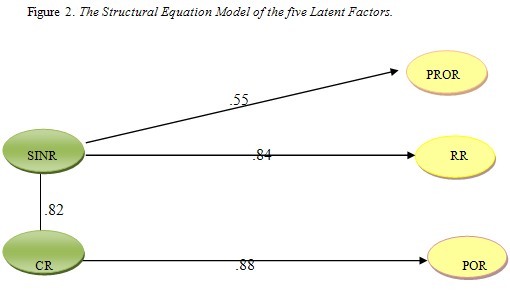
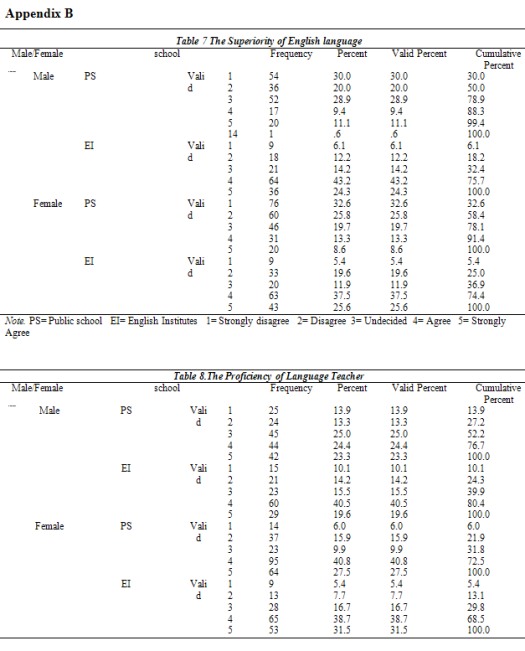
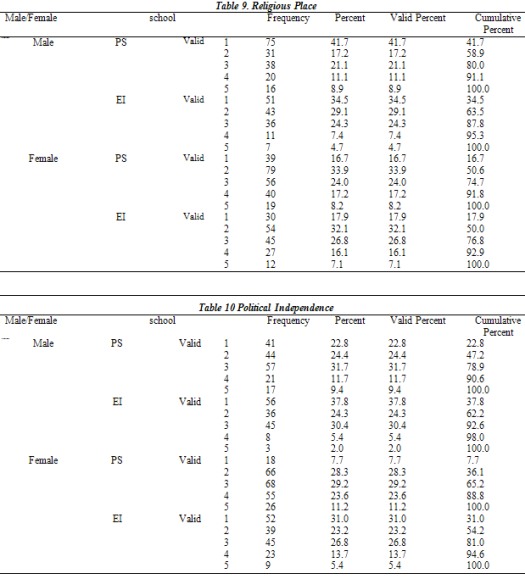

Please check the How to be a Teacher Trainer course at Pilgrims website.


|